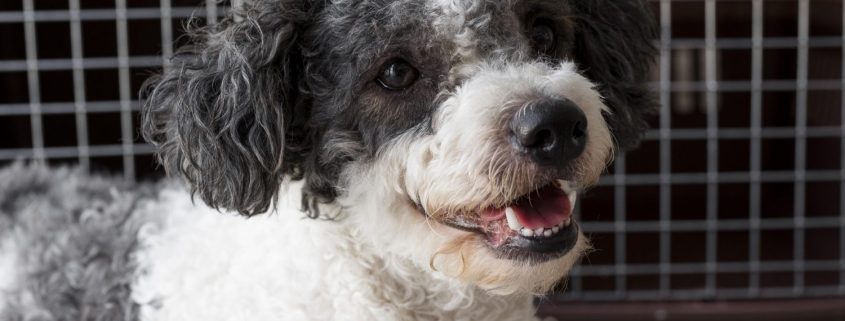Ask Crystal: Adult Dog Crate Training
Welcome to “Ask Crystal,” where you can ask your pet behavior questions! You can submit your question for Crystal at the bottom of the page!

Dear Crystal,
I adopted a one-year-old Bichon Friese 1 week ago. My dog has never been crate trained. He slept in his owner’s bed. I have set the crate up in my living room and I feed him all meals in his crate. He gets treats to go in there. I do have a Kong and I use it.
He does get his whole body in but won’t stay in it. He does end up sleeping in my bed at night. I haven’t tried closing the crate door yet. What should my next step be?
Thanks for your reply,
New Dog Mom
Dear New,
Congratulations on your new addition! I am so happy to hear that you are already starting to work on his crate training. It is great that you aren’t trying to make him sleep in there before he is ready. Moving too quickly is one of the biggest mistakes people seem to make with crate training. If you are able to get him to accept the crate, it will make managing him so much easier while you working on teaching him how to behave in a home. Crates aren’t necessarily the right choice for every dog but for most dogs they can be a really useful tool.
The time it takes to get a dog used to the crate can vary. Adult dogs don’t learn as quickly as puppies do. They usually need more repetitions for things to sink in. Depending on your dog’s personality, they can sometimes be resistant to it. The history of crate use also impacts the time it takes to train the behavior. Luckily, he has no previous exposure to it so he doesn’t have a negative history with it.
The first steps are usually just getting the dog to the point where he will go in and out on his own without you making him go in. We accomplish that by leaving the door open and randomly tossing treats in there for him to find throughout the day. Once he shows comfort going in and out of his own accord, we can move to purposely moving him in and out. If he will go in on his own without you telling him to, I would say you can move on. Otherwise, maybe do a few days of randomly tossing treats in there for him to find.
 The next step is feeding in the crate which you are doing. The door is open at this step. You can tie it open if there is any concern it might accidently shut and scare him. In addition, to feeding in the crate we want to give the dog special toys and treats in the crate. Dogs that like to play with toys often enjoy running in and out to fetch their favorite toy. You can play a little game of tug with him. Leave amazing treats and bones for him to find in there.
The next step is feeding in the crate which you are doing. The door is open at this step. You can tie it open if there is any concern it might accidently shut and scare him. In addition, to feeding in the crate we want to give the dog special toys and treats in the crate. Dogs that like to play with toys often enjoy running in and out to fetch their favorite toy. You can play a little game of tug with him. Leave amazing treats and bones for him to find in there.
Consider teaching him cues for going in and out of the crate. Say your cue word, “kennel”, point and toss a treat inside. Be sure to say the word first and then toss the treat inside so he can make the association of the word and the action. You can also work on a cue at this time for releasing him. Once he is inside the crate, say “out” and the toss the treat outside the crate. Practice this many times for him to learn the cues.
The next step would be delaying the time that you release him from his kennel. While he is inside with the door open, feed him a treat about every 2-3 seconds and release after 10 seconds. You can gradually build up the duration of time inside and slow down the delivery rate. Only change one factor at a time so we don’t make it too hard all at once. Once he can stay in there for 20 seconds with one treat, you may be able to move onto closing the door.
The process for closing the door is similar to the prior procedure in that we start out with a short duration of time with the door shut and a fast delivery rate. Shut the door for one second, toss a treat in and open it and let him out. It’s important in the beginning that you are just shutting the door and opening it and not leaving the room yet. Start to increase the time that the door is shut and feed treats through the bars. Then start feeding treats at random intervals so he can’t predict when they will come. As you start to increase the time in the kennel, you may close the door for a few minutes while you are in the room and feeding him treats occasionally.
You may be able to try having him in the crate overnight at this point. The fact that the crate is in the living room might be an issue especially if he is used to sleeping in bed. You may want a crate in the bedroom if he is too fussy at being isolated. You can slowly with time move the crate outside of the bedroom with time. It might be fine but if he won’t calm down after an hour or more, I would suggest the crate in the bedroom or try the following steps before having him sleep in it. Remember to wait for a few seconds of quiet before he gets released from the kennel.
Once your dog can sit in the crate for five minutes calmly and only need one treat you can move to leaving the room. Walk out of sight for a few seconds and then come back and give a treat. Gradually increase the time you are gone from the room. Once he is calm alone for 10 minutes, you can start adding on time pretty quickly.
 Once you are leaving him in there for 30 minutes or more, be sure you are giving him the kong and his favorite chew toys to keep him occupied. When you get back and let him out, take the toys out so he only gets them when he is in the crate. This will help create an association with the crate being where he gets special toys.
Once you are leaving him in there for 30 minutes or more, be sure you are giving him the kong and his favorite chew toys to keep him occupied. When you get back and let him out, take the toys out so he only gets them when he is in the crate. This will help create an association with the crate being where he gets special toys.
Next, start actually leaving the house for a few minutes. Maybe walk to the mailbox or just sit outside and read. It can be harder for some dogs if they hear you leave the house so this is a good step to gradually get the dog used to. Again, slowly increase the time you leave him in the crate and leave the house.
Depending on your dog, you may be able to go through the steps pretty quickly. It’s always best to let the dog dictate the speed of progress. He should never be forced in and he should appear by all accounts comfortable before moving on. Taking the time now will hopefully lead to a pup that will easily kennel up when needed and be completely comfortable with it. Good luck!
Until next time,
Crystal

 Dog photo created by freepik - www.freepik.com
Dog photo created by freepik - www.freepik.com




